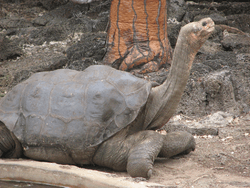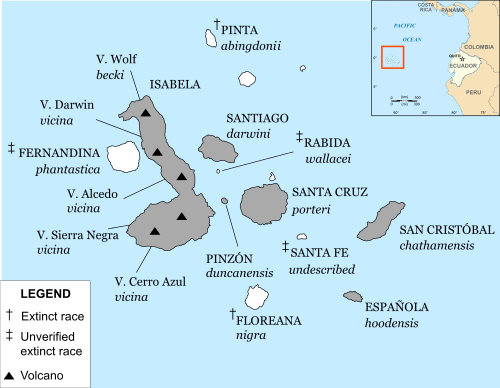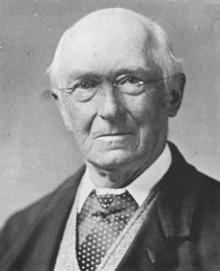Pinta Island tortoise
| Pinta Island tortoise | |
|---|---|
 | |
| Lonesome George at the Charles Darwin Research Station in 2006, the last known individual of his species of Galápagos tortoise | |
| Probably extinct | |
| Scientific classification | |
| Kingdom: | Animalia |
| Phylum: | Chordata |
| Subphylum: | Vertebrata |
| Class: | Reptilia |
| Order: | Testudines |
| Family: | Testudinidae |
| Genus: | Chelonoidis |
| Species: | C. abingdonii |
| Binomial name | |
| Chelonoidis abingdonii (Günther, 1877)[1] | |
 | |
| Map of the Galápagos Islands indicating species' locations | |
The Pinta Island tortoise[2] (Chelonoidis nigra abingdonii[1][3]), also known as the Pinta giant tortoise,[1] Abingdon Island tortoise,[4] or Abingdon Island giant tortoise,[1] is a species of Galápagos tortoise native to Ecuador's Pinta Island that is probably extinct.[5]
The species was described by Albert Günther in 1877 after specimens arrived in London. By the end of the 19th century, most of the Pinta Island tortoises had been wiped out due to hunting.[6] By the mid-20th century, the species was assumed to be extinct until a single male was discovered on the island in 1971. Efforts were made to mate the male, named Lonesome George, with other species, but no viable eggs were produced. Lonesome George died on 24 June 2012 and the species was believed to have become extinct with his death.[7] However, 17 first-generation hybrids have been found at Wolf Volcano on Isabela Island during a recent trip by Yale University researchers. As these specimens are juveniles, their parents may still be alive.[8]
Taxonomy

"Lonesome George" along with other of the tortoises on Pinta Island, belong to a genus of 21 species. Giant tortoises were widespread on most of the continents except for Australia and Antarctica. Not only do the Galapagos tortoises remain the largest living tortoises, but in the Galapagos, distinct populations survived in multiple localities.
Several of the surviving species of Galapagos tortoises are seriously endangered. Lonesome George was the perfect example. It is said that the decline of the population began in the 17th century, due to buccaneers and whalers. They hunted tortoises as a source of fresh meat, and took away about 200,000 tortoises collectively.

This species was originally described in 1877 by German-born British herpetologist Albert Günther, who named it Testudo abingdonii, a new species, in his book The Gigantic Land-tortoises (Living and Extinct) in the Collection of the British Museum.[3][9] The name, abingdonii, derives from Abingdon Island, now more commonly known as Pinta Island. The knowledge of its existence was derived from short statements of the voyages of Captain James Colnett in 1798 and Basil Hall in 1822.[9] In 1876 Commander William Cookson[10] brought three male specimens (along with other species of Galápagos tortoise) to London aboard the Royal Navy ship HMS Peterel.[9][11]
Some synonyms of Chelonoidis nigra abingdonii are: Testudo abingdonii Günther, 1877; Testudo elephantopus abingdonii – Mertens & Wermuth, 1955; Geochelone elephantopus abingdonii – Pritchard, 1967; Geochelone nigra abingdonii – Iverson, 1992; Geochelone abingdonii – Valverde, 2004.[12]
Evolution
The origin and systematic relationships are still unresolved today, it even captivated Charles Darwin himself. Scientists used DNA sequencing and decided to collect a few tortoises from the Pinta Island in 1906. With DNA sequencing as their method, their results show that the three best candidates for the closest living relative of the Galapagos tortoises are all located in South America. It is the yellow-footed tortoise (Geochelone denticulata), the red-footed tortoise (Geochelone carbonara), and the Chaco tortoise (Geochelone chilensis). These 3 species are known as extant species.
Behaviour and ecology
During their time on the island, the Galapagos Tortoise, including the Pinta Island species, was observed many times and it was concluded that the tortoises rest about 16 hours a day. The Galapagos tortoises are herbivores who feed primarily on greens, grasses, native fruit, and cactus pads. These tortoises also drink heavy quantities of water which they can then store in their bodies for long periods of time and utilize later. They can reportedly survive up to six months without any food or water.
For breeding, the tortoises are most active during the "hot season" (January to May) and then during the cool season (June to November), female tortoises migrate to nesting zones in order to lay out their offspring.
The effort to conserve species to increase biodiversity is a very important aspect of life involving economic, social and cultural values with phylogenetic, biogeographic, ecological and demographic indulgence. Galapagos giant tortoises provide a great example of this as they represent the top mega-herbivores that aid in shaping Galapagos ecosystems. They provide critical ecosystem services by seed dispersing and by being ecological engineers through herbivory and nutrient cycling. Due to the extinction of many of these large herbivores, ecosystem functioning has diminished worldwide.[13]
Seed dispersal
On the Island of Santa Cruz near the geographic center of the Galapagos, there was a study done by Blake et al. on seed dispersal by Galapagos tortoises. In order to determine the number of seeds spread, they identified and counted intact seeds from 120 fresh dung piles in both the agricultural and natural park land. To obtain the distance seeds were moved by tortoises they used an estimated digesta retention time from captive tortoises as a proxy for retention times of wild tortoises and data for the tracking of the tortoises was obtained from GPS telemetry. Germination trials were administered for five plant species to determine whether germination success was influence by tortoises. In the results, it was found that there were over 45 plant seeds still intact. On average tortoises defecated 464 (SE 95) and 2.8 (SE 0.2) species per dung pile. Seeds were found over long distances where turtles had transported them. However, there was no evidence found that tortoise ingestion or the presence of dung influenced the success of seed germination. In conclusion, it was discovered that Galapagos tortoises are colossal seed dispersers, regularly transporting a vast amount of seeds over distances. More extensive research is needed to quantify germination success, demography of plants under natural conditions, with and without tortoise dispersal to determine the seed dispersal effectiveness of Galapagos tortoises.[14]
Relationship with humans
Conservation efforts
In 1958, goats immigrated to Pinta Island, Galapagos began eating much of the herbs and shrubs to the detriment of the natural habitat.[15][16] A prolonged effort to exterminate the goats was initiated. As the goat populations declined, the vegetation underwent an amazing recovery. Small trees began regenerating from the stumps left by the goats. Highland shrub species, forest tree seedlings, Opuntia cactus, and other endemic species increased. In 2003, Pinta Island was declared "goat-free".[17]
In addition to current conservation efforts such as the elimination of goat populations in the Galapagos, there has been a new effort to revive a number of species of Galapagos tortoise. There is new information which states that from 12 females and 3 male tortoises there came around 1700 offspring which now live in the Galapagos area. Many of these offspring also coincide with many species of Galapagos tortoise, such as the vital Pinta Island Galapagos tortoise. The statistics also show that compared to a 3% hatching rate in 2004, in 2007 there was a 24% hatching rate which gave an unprecedented rise in tortoise population. This also shows that the number of animals in a species can rise despite genetic variation.
Lonesome George

The last known individual of the species was a male named Lonesome George[18] (Spanish: El Solitario Jorge/George),[19] who died on 24 June 2012.[19][20][21] In his last years, he was known as the rarest creature in the world. George served as a potent symbol for conservation efforts in the Galápagos and internationally.[22]
George was first seen on the island of Pinta on 1 December 1971 by Hungarian malacologist József Vágvölgyi. Relocated for his safety to the Charles Darwin Research Station on Santa Cruz Island, George was penned with two females of a different species. Although eggs were produced, none hatched. The Pinta tortoise was pronounced functionally extinct as George was in captivity.
Over the decades, all attempts at mating Lonesome George had been unsuccessful, possibly due to the lack of females of his own species.
On 24 June 2012, at 8:00 am local time, Director of the Galápagos National Park Edwin Naula announced that Lonesome George had been found dead[23][24][25] by his caretaker of 40 years, Fausto Llerena.[26] Naula suspects that the cause of death was heart failure consistent with the end of the natural lifecycle of a tortoise.
Possible remaining individuals
In 2006, Peter Pritchard, one of the world’s foremost authorities on Galapagos tortoises, suggested that a male tortoise residing in the Prague Zoo might be a Pinta Island tortoise due to its shell structure.[27][28] Subsequent DNA analysis, however, revealed it was more likely to be from Pinzón Island, home of the species C. duncanensis.[1][28][29]
Whalers and pirates of the past used Isabela Island, the central and largest of the Galápagos Islands, as a tortoise dumping ground. Today, the remaining tortoises that live around Wolf Volcano have combined genetic markers from several species.[30][31] In May 2007, analysis of genomic microsatellites (DNA sequences) suggested that individuals from a translocated group of C. n. abingdonii may still exist in the wild on Isabela.[32] Researchers have identified one male tortoise from the Volcano Wolf region, which has half his genes in common with George's species. This animal must be a first-generation intergrade between the species of the islands Isabela and Pinta.[32] A pure Pinta tortoise possibly lives among the 2,000 tortoises on Isabela.[33]
The identification of eight individuals of mixed ancestry among only 27 individuals sampled (estimated Volcano Wolf population size 1,000–2,000)… suggests the need to mount an immediate and comprehensive survey… to search for additional individuals of Pinta ancestry.[32]
A recent trek to Isabela by Yale University researchers revealed that there are 17 first-generation hybrids living at Wolf Volcano.[8] The researchers plan on returning to Isabela in the spring of 2013 to look for surviving Pinta and to try to collect hybrids in an effort to start a captive selective-breeding program and to hopefully reintroduce Pintas back to their native island.[8]
See also
References
- 1 2 3 4 5 van Dijk, Peter Paul; Iverson, John B.; Shaffer, H. Bradley; Bour, Roger; Rhodin, Anders G. J. (2011). "Turtles of the World, 2011 Update: Annotated Checklist of Taxonomy, Synonymy, Distribution, and Conservation Status". In Rhodin, Anders G.J.; Pritchard, Peter C. H.; van Dijk, Peter Paul; Saumure, Raymond A.; Buhlmann, Kurt A.; Iverson, John B.; Mittermeier, Russell A. Conservation Biology of Freshwater Turtles and Tortoises. Chelonian Research Monographs, Number 5. p. 000.197. doi:10.3854/crm.5.000.checklist.v4.2011. OCLC 472656069.
- ↑ Reynolds, Robert P.; Marlow, Ronald W. (1983). "Lonesome George, the Pinta Island Tortoise: A Case of Limited Alternatives". Noticias de Galápagos. Charles Darwin Foundation for the Galapagos Isles. 37: 14–7.
- 1 2 Fritz, Uwe; Havaš, Peter (2007). "Checklist of chelonians of the world" (PDF). Vertebrate Zoology. 57 (2): 271. Archived from the original (PDF) on 2010-12-17.
- ↑ Cayot, L.J., Gibbs, J.P., Tapia, W. & Caccone, A. (2016). "Chelonoidis abingdonii". IUCN Red List of Threatened Species. IUCN. 2016: e.T9017A65487433. Retrieved 1 September 2016.
- ↑ Tortoise & Freshwater Turtle Specialist Group (2016). "Chelonoidis nigra". IUCN Red List of Threatened Species. IUCN. 2016: e.T9023A97224409. Retrieved 1 September 2016.
- ↑ Nicholls, Henry (2007). Lonesome George: The Life and Loves of the World's Most Famous Tortoise. London: Pan Books. p. 2. ISBN 0330450115.
- ↑ Jones, Bryony (25 June 2012). "Lonesome George, last of the Pinta Island tortoises, dies". CNN. Retrieved 25 June 2012.
- 1 2 3 "Galapagos Tortoise 'Lonesome George' May Have Company". LiveScience. Retrieved 27 November 2012.
- 1 2 3 G̀eunther, Albert Carl Ludwig Gotthilf (1877). The gigantic land tortoises (living and extinct) in the collection of the British Museum. British Museum, Dept. of Zoology, London.
- ↑ "Biography of William Edgar De Crackenthorpe Cookson R.N.".
- ↑ "mid-Victorian RN vessels HMS Peterel".
- ↑ "Chelonoidis abingdonii (GÜNTHER, 1877)". The Reptile Database.
- ↑ Edwards, Danielle; Benavides, Edgar; Garrick, Ryan (January 2013). "The genetic legacy of Lonesome George survives: Giant tortoises with Pinta Island ancestry identified in Galápagos". Biological Conservation. 157: 225–228. doi:10.1016/j.biocon.2012.10.014.
- ↑ Blake; et al. (2012). "Seed dispersal by Galapagos tortoises" (PDF). Journal of Biogeography. 39: 1961–1972. doi:10.1111/j.1365-2699.2011.02672.x. Retrieved October 30, 2015.
- ↑ "Galapagos Geology on the Web". Cornell University.
- ↑ Eradication of feral goats Capra hircus from Pinta Island, Galápagos, Ecuador
- ↑ "Lonesome George". Galapagos Conservancy. Retrieved May 5, 2015.
- ↑ Gardner, Simon (6 February 2001). "Lonesome George faces own Galapagos tortoise curse". Archived from the original on 2011-06-04. Retrieved 2012-01-11.
- 1 2 Proceso de Relaciones Públicas de la Dirección del Parque Nacional Galápagos (24 June 2012). "El mundo pierde al solitario George". Retrieved 2012-06-25.
- ↑ "Lonesome George, last-of-his-kind Galapagos tortoise, dies". 25 June 2012.
- ↑ Raferty, Isolde. "Lonesome George, last-of-its-kind Galapagos tortoise, dies". MSNBC. Retrieved 2012-06-24.
- ↑ Nicholls, Henry (2006). Lonesome George: The Life and Loves of a Conservation Icon. London: Macmillan Science. ISBN 1-4039-4576-4.
- ↑ "Lonesome George, last of the Pinta Island tortoises, dies". CNN. Retrieved 25 June 2012.
- ↑ "Giant tortoise Lonesome George's death leaves the world one subspecies poorer". nationalpost.com. Retrieved 25 June 2012.
- ↑ "Lonesome George, last-of-his-kind Galapagos tortoise, dies". IBN Live. Retrieved 25 June 2012.
- ↑ "Muere el Solitario George, la última tortuga gigante de isla Pinta". El Unveriso. Archived from the original on 2013-01-15. Retrieved 24 June 2012.
- ↑ Sulloway, Frank J. (July 28, 2006). "Is Lonesome George Really Lonesome?". eSkeptic. ISSN 1556-5696. Retrieved 2012-01-11.
- 1 2 Nicholls, Henry (2007). Lonesome George: The Life and Loves of the World's Most Famous Tortoise. London: Pan Books. p. 142. ISBN 0330450115.
- ↑ Russello, M. A.; et al. (2007). "Lineage identification of Galápagos tortoises in captivity worldwide". Animal Conservation. 10 (3): 304–311. doi:10.1111/j.1469-1795.2007.00113.x.
- ↑ Marshall, Michael (26 June 2012). "Lonesome George dies but his subspecies genes survive". New Scientist. Retrieved 2012-06-26.
- ↑ Nicholls, Henry (6 June 2007). "Galapagos tortoises: untangling the evolutionary threads". New Scientist. Retrieved 2012-06-26.
- 1 2 3 Russello, Michael A.; Beheregaray, Luciano B.; Gibbs, James P.; Fritts, Thomas; Havill, Nathan; Powell, Jeffrey R.; Caccone, Adalgisa (1 May 2007). "Lonesome George is not alone among Galápagos tortoises" (PDF). Current Biology. 17 (9): R317–R318. doi:10.1016/j.cub.2007.03.002. PMID 17470342. Retrieved 2012-01-11.
- ↑ "Iconic tortoise George may not be last of his kind". ABC News. Agence France-Presse. May 1, 2007. Retrieved 2012-01-11.
- Caccone, Adalgisa; Gibbs, James P.; Ketmaier, Valerio; Suatoni, Elizabeth; Powell, Jeffrey R. (1999-11-09). "Origin and evolutionary relationships of giant Galápagos tortoises". Proceedings of the National Academy of Sciences. 96 (23): 13223–13228. doi:10.1073/pnas.96.23.13223. ISSN 0027-8424. PMC 23929
 . PMID 10557302.
. PMID 10557302. - Nicholls, Henry (2004-06-03). "Tortoise conservation: One of a kind". Nature. 429 (6991): 498–500. doi:10.1038/429498a. ISSN 0028-0836.
- Giant Tortoises, Galapagos Conservancy
- Recovery of a nearly extinct Galápagos tortoise despite minimal genetic variation., Wiley Online Library
- [1]
External links
| Wikimedia Commons has media related to Chelonoidis nigra abingdoni. |
- Naked Scientists audio discussion of Lonesome George
- Article on Lonesome George The giant tortoise of Galapagos Island.
- Lonesome George, by Vicki Seal
- "Team of Veterinarians Prepare Hybrid Tortoises for Release on Pinta Island in 2010" (Press release). Galapagos Conservancy. February 3, 2010. Archived from the original on February 8, 2010.
- Garrick, Ryan C.; Benavides, Edgar; Russello, Michael A.; Gibbs, James P.; et al. (2012). "Genetic rediscovery of an 'extinct' Galápagos giant tortoise species". Current Biology. 22 (1): R10–1. doi:10.1016/j.cub.2011.12.004. PMID 22240469.
- ↑ Edwards, Danielle L.; Benavides, Edgar; Garrick, Ryan C.; Gibbs, James P.; Russello, Michael A.; Dion, Kirstin B.; Hyseni, Chaz; Flanagan, Joseph P.; Tapia, Washington (2013-01-01). "The genetic legacy of Lonesome George survives: Giant tortoises with Pinta Island ancestry identified in Galápagos". Biological Conservation. 157: 225–228. doi:10.1016/j.biocon.2012.10.014.
